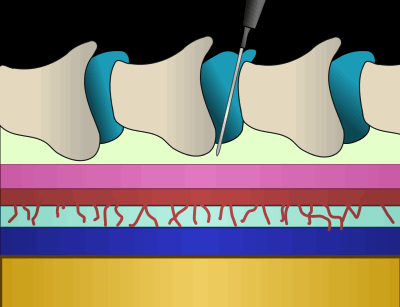Epidural Headache: Finding Relief
Yes, you could actually experience an epidural headache (although that’s not the technical name for it – more on that in a moment). Although unusual, it is common enough to be a well known condition in the medical community.
So, I thought an epidural was supposed to reduce pain! How did I end up with this terrible epidural headache?
Sometimes, when the needle injects your anaesthetic, it punctures the “dura”, a bag containing cerebro-spinal fluid (CSF). Some patients are at higher risk of this happening than others (if you’re still considering an epidural, discuss this with your anaesthetist). Only about 3 patients in 200 tend to get this type of headache after an epidural.

Many people call this an epidural headache when it happens after an epidural, but there are various reasons why the dura may be punctured. The correct term for this type of headache is a post-dural puncture headache (PDPH) (formerly a post-lumbar puncture headache).
This condition may last for a number of weeks, while the hole in the dura heals.
Treatment of Epidural Headache
If you’re experiencing new headache symptoms after your epidural, discuss your symptoms with your doctor. Common ways to manage the headache include:
- Lying down and resting when the pain is bad.
- Certain medications to lessen the pain.
- Drinking plenty of fluids (don’t over-do it – just a normal, healthy amount of fluids) (believe it or not, some people find tea or coffee especially helpful).
- Avoid lifting or straining.
If the pain is really bad and not going away, your doctor may recommend an epidural blood patch. This is like an epidural (and so does have a small risk of causing another puncture, or a back ache), but it basically plugs the hole. The symptoms usually go away fairly quickly, although it doesn’t work for everyone.
Do not just “put up with” an epidural headache. Talk to your doctor, and find a treatment that works for you. If the pain lasts longer than a few days, go back to your doctor to try something else.
Read this article from Clinical Pain Advisor for more detailed information on epidural headache.

29 June 2018 @ 2:05 am
I had a lumbar puncture 20 years ago and hope I never have another one. I spent an entire week in bed with the worst migraine of my life. I couldn’t tolerate light or sound and I was so nauseated I couldn’t eat. Even drinking water was painful since I had to sit up. I don’t remember the doctor even suggesting a blood patch. I never heard of them until at least 10 years after I had my lumbar puncture. That was the only time I have ever thought about suicide. It felt like it was never going to end and every part of my body was screaming in pain. None of the pain killers I was given even took the edge off.